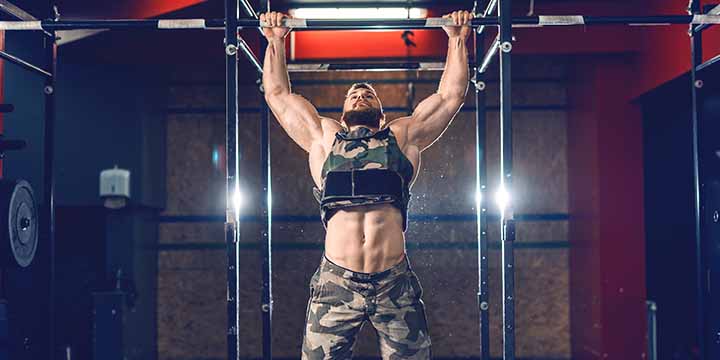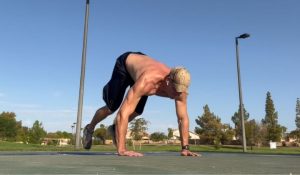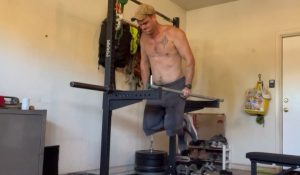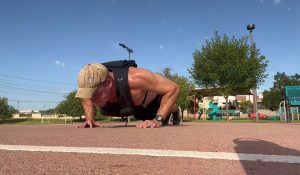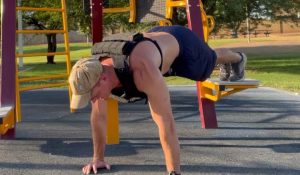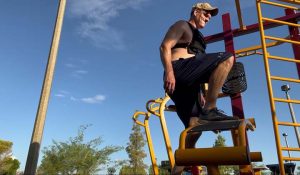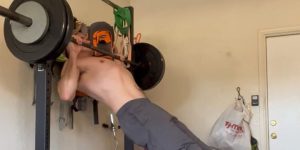For the majority of the last couple of years, I have been doing all of my almost exclusively with a weight vest. What began with a simple obsession with completing a Murph challenge for the first time has led to new knowledge about the benefits of weighted vest training for working out efficiently.
What I thought was going to be a simple Fitness “side quest“ ended up becoming my main method of training. The reasons for this include the fact that I can get a simple efficient and time efficient training session time.
I have found that my strength on the main barbell lifts has not gone down by much (yes, I did test this out), but I have also lost weight and I am in significantly better shape.
After a few months of training in this way, I began giving some of my methods to some friends who were wondering what I was doing. After all, having two kids and running a business is supposed to make you “let yourself go,” right? A number of them tried it, and so far, they’ve all reported that they basically abandoned their old training styles.
Why? Let’s discuss:
Benefits of strength training with a weight vest

I could discuss that using external resistance has positive effects on your bone mass, muscular endurance, and burns more calories per unit of time … but I’m going to assume you already know most of that.
What I’d like to discuss here are the benefits of weighted vest training over other types of lifting – the types of benefits that got a former barbell purist or calisthenics purist to reconsider their logic.
The main benefits of using a weighted vest for strength training are that:
- It doesn’t encourage weight gain like barbell training does
- It allows for a much higher strength ceiling than basic bodyweight training
- It opens the door to “resistance cardio”, unlike traditional lifting
- Weight vest workouts save time
- It takes up far less space than a traditional gym setup
1. Doesn’t encourage weight gain (like barbell training does)
Barbell lifting, when done properly, encourages fat gain in order to see progress in our numbers. This is not a bad thing, per se … it’s just part of the game. While a well-executed cycle of bulking and cutting addresses this issue nicely, most of us regular guys aren’t that interested in obsessing over spreadsheets and periodization models.
In weight vest training, your numbers on basic compound exercises (push-ups, pull-ups, etc.) go up when you lose fat. Imagine that.
The reason for this is that most of the exercises we will be doing are going to be variations of calisthenic exercises. Weighted push-ups, pull-ups, squats, rows, lunges, dips. Numbers on these exercises actually go up when we lose weight, not down.
Weight vest training can be done year-round. It does not require bulking and cutting. It doesn’t require planning quarterly or yearly training cycles. It just requires work and consistency.
Most of us just want to look better, be pain-free, be in shape, and be strong. We want to be what Jim Wendler calls the Suburban Commando: “able to mow any lawn, shovel any driveway or clean out any amount of gutters.”
I relate to that statement. Do you? If you do, then weight vest training might be for you.
Some of us simply love to watch our numbers on the big barbell lifts go up. I would have included myself in this group a couple of years ago. However, most of us don’t care very much about that, if we’re being honest with ourselves.
I have not felt the need to cut or “lose weight” the entire time. In fact, this method of training has simply just done it for me.
2. The strength ceiling is much higher than regular bodyweight training
While bodyweight exercises don’t suffer from the problem of encouraging weight gain, they introduce another problem.
Most of us who have put effort into improving the number of push-ups, pull-ups, or squats we can do have noticed after a while that as the number of reps we can do increases, the repetitions begin to feel endless, and the progress starts to stall.
This is to be expected – those who live and die by arbitrary rep PRs seem to plateau.
The added weight of wearing a weighted vest for these basic exercises can (WILL!) spark new progress. The number of full range of motion repetitions you’ll be able to do will increase, and new improvements in muscle mass will materialize.
Once you hit this same plateau again … no problem, simply throw some heavier weights into your vest and keep at it.
It’s amazing to watch someone who’s been “stuck” at 10 pull-ups for 6 months try some weighted vest training for a while and suddenly be able to do 15 pull-ups after two months.
3. Weight vest training is “resistance cardio”

Another weighted vest benefit is that it opens the possibility for true “resistance cardio” training. I mean this aside from the obvious benefit that a weight vest can also be effectively used for running, hiking, walking, and numerous other activities.
I tend to harp on this subject, and that’s because there’s still a belief out there that it isn’t possible to do effective resistance training and cardio at the same time (or that it’s simply suboptimal).
Yes, I’ve heard of the interference effect (those still worried about this should read Greg Nuckols’ article entitled, “The interference effect is getting less scary by the day”). I am aware that I am supposed to separate my resistance training and cardio sessions by at least six hours, according to science.
Maybe if we were trying to compete in a sport at an elite level or reach world-class levels of fitness, it would make more sense to follow these guidelines. But most of us aren’t.
Once I transitioned to weighted vest training, I realized that my level of fitness was improving gradually without having to do any “true“ cardio!
The reason for this is simple:
With barbell exercises, we need to breathe and brace on every exercise. Try as I may, I haven’t found a way to do this comfortably when I’m simply out of breath. The times that I’ve tried, I’ve basically ended up with a sore back because I find it extremely difficult to breathe and brace properly while breathing heavily.
Exercises like push-ups, pull-ups, dips, rows, weight vest squats, etc, don’t require a proper breathe and brace. I receive the same amount of tension on the target muscle as if I was doing a bench press or a barbell row, but I could do it while breathing heavily, without having to take rest periods.
This means that it unlocks the possibility of doing old-school circuit training or antagonistic supersets without sacrificing much progress from a hypertrophy standpoint.
Gone are the days of being strong, but not being able to run across the soccer field with my kids to chase a ball and then needing a break afterward. I get to truly say that I am “in shape“, without having to sacrifice the benefits of resistance training.
4. It saves time
In the past when I’ve been doing traditional lifting, I have always felt like I was walking a balancing act. I was either working on cardiovascular goals (such as improving endurance to complete a Spartan Race), or I was lifting, say, to prepare for a powerlifting meet.
If I wanted to do cardio, I couldn’t lift weights heavy enough to actually inspire progress on those lifts. Conversely, if I wanted to drive strength progress, I would have to recover between sets, eliminating much of the cardiovascular benefit of strength training.
The end result is that I would have to choose: are we working on strength and muscularity, or are we working on cardiovascular fitness? If I wanted to be both strong and in shape, I’d have to double the number of workouts I was doing. Not conducive to a busy schedule!
Throwing on a weight vest reverses all this:
By simply completing a set of one exercise near failure, then standing up and doing another, then doing a third, I had rested the target muscle long enough that I could take a quick 30-second break, come back, and hit it again.
The muscle was fresh (recovered), but I still got the cardiovascular training a fact of having been exercising the entire time without a break. Combine this with a pyramid-style rep scheme and you’ll have a nice, compact workout with a built-in warm-up and cool-down.
5. It saves space
While we all love having a full gym set up, complete with the squat rack, barbell, weight, plates, dumbbells, cables, hyperextensions, and everything else under the sun, it’s not always realistic to put this stuff in the garage or spare bedroom.
Never was this more obvious to me than when I lived in an apartment where we had our first child. Our “gym“ was literally in the apartment’s spare room. The wife and I really had to really think about priorities.
Filling that room up with gym equipment would’ve meant we basically couldn’t use the room for anything else. This was a challenge for us because we basically also used that room as an office.
Using a weight vest and a pull-up bar, all of a sudden my options were open. I could push, pull, legs, whatever else I wanted, without having to clutter the room up with tons and tons of exercise equipment.
In theory, I didn’t even have to have the pull-up bar – I could have just done push-ups and squat supersets, and added some “dumbbell-style” rows at the end, holding the weighted best by the straps.
The fact is that my simple little weight vest full of 2.5-pound ingots takes up less space than basically any piece of equipment I could have bought, except for maybe resistance bands.
The other advantage is in portability:
- Driving to California for a weekend that grandpa‘s house? Throw the white vest in the trunk.
- Driving to the mountains for a week at the cabin? Throw the white vest in the trunk.
- Need your entire gym to take up no more than a 2‘ x 2‘ piece of floor space? The weight vest fits, nice and snug.
(As a side note, this is why I prefer “ingot“ style weight vests, as opposed to “plate“ style weight vests, like the Rogue or 5.11)

You just simply can’t get more space-saving than a weight vest.
Limitations of using a weight vest
I’m aware that up until this point, I’ve been basically expressing that the weighted vest is the best thing since sliced bread. However, I’d be remiss if I didn’t point out that there are some clear downsides.
We have to assess what our goals are to be.
If your goal is to get as strong as humanly possible, and you care about little else, then weight vest strength training is likely not for you. However, it’s also likely that you already knew that.
If your goal is to get as jacked as possible (aka bodybuilding), then you are probably better served by going to a legitimate gym, complete with dumbbell racks, all manner of benches, cable machines, barbells, and everything else. If this is the case, then, wait, this training is also likely not for you.
If you are training for a sport that has a higher recovery demand, then it’s also possible that training with the weight fast may tap out your recovery resources. This will likely be assessed on a case-by-case basis. If this describes you, it’s also likely that you’ll have to do some experimentation before you decide whether or not training with a weight vest, makes the most sense for you.
So, who should consider using a weighted vest?
As you can see, it’s truly goal dependent. For the average human (who is busy and doesn’t have the time, nor the inclination to pour over spreadsheets and plan training cycles), something like weight vest training makes a lot of sense.
It makes sense for anyone who lacks the time and mental energy but doesn’t want to compromise their physical practice as time rolls on.
In the near future, I’m planning to write up some basic programs using this methodology, and we’ll discuss that it’s actually very possible to make progress using these methods.
Until then, happy lifting!
